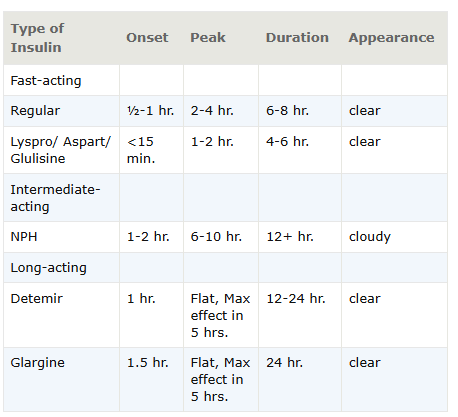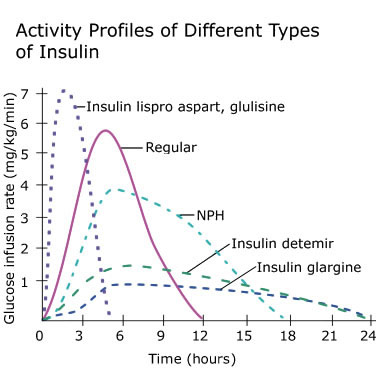Human Insulin and Insulin Analogs are available for insulin replacement therapy. Insulins also are classified by the timing of their action in your body – specifically, how quickly they start to act, when they have a maximal effect, and how long they act. Insulin analogs have been developed because of limitations with human insulins such as slow and unpredictable absorption. Insulin analogs which have largely replaced the use of human insulin, have a more predictable duration of action. The rapid-acting insulin analogs work more quickly, and the long-acting insulin analogs last longer and have a more even, "peakless" effect.
Background
Insulin has been available since 1921. It was initially extracted from beef and pork pancreases. In the early 1980s, technology became available to produce human insulin synthetically. Synthetic human insulin has replaced beef and pork insulin in the US. And now, insulin analogs are replacing human insulin.Characteristics of Insulin
Insulins are categorized by differences in:- Onset: How quickly they act.
- Peak: How long it takes to achieve maximum impact.
- Duration: How long they last before they wear off.
- Concentration: Insulins sold in the U.S. have a concentration of 100 units per ml or U100, more concentrated options are also available though less commonly used. Be sure to pay close attention to the concentration for use with insulin pump as they do not adjust for more concentrated insulin.
- Route of delivery: Whether they are injected under the skin, inhaled or given intravenously.
Insulin is usually injected into the fatty tissue just under the skin. This is also called subcutaneous tissue.
See a table of insulin action below and a graphic illustration of onset of action, peak effect and duration of action of the different insulins.
Types of Insulin
There are three main groups of insulins: Fast-acting, Intermediate-acting and Long-acting insulin.
Fast-acting insulin
- Is absorbed quickly from your fat tissue (subcutaneous) into the bloodstream.
- Is used to control the blood sugar during meals and snacks and to correct high blood sugars
Includes:
Rapid Acting Insulin Analogs (Insulin Aspart, Insulin Lispro, Insulin Glulisine) which have an onset of action of 5 to 15 minutes, peak effect in 1 to 2 hours and duration of action that lasts 4-6 hours. With all doses, large and small, the onset of action and the time to peak effect is similar. The duration of insulin action is, however, affected by the dose – so a few units may last 4 hours or less, while 25 or 30 units may last 5 to 6 hours. As a general rule, assume that these insulins have a duration of action of 4 hours.
Regular Human Insulin which has an onset of action of 1/2 hour to 1 hour, peak effect in 2 to 4 hours, and duration of action of 6 to 8 hours. The larger the dose of regular the faster the onset of action, but the longer the time to peak effect and the longer the duration of the effect.
Intermediate-acting insulin:
- Is absorbed more slowly, and lasts longer
- Is used to control blood glucose overnight, while fasting and between meals
Includes:
NPH Human Insulin which has an onset of insulin effect of 1 to 2 hours, a peak effect of 4 to 6 hours, and duration of action of more than 12 hours. Very small doses will have an earlier peak effect and shorter duration of action, while higher doses will have a longer time to peak effect and prolonged duration.
Pre-Mixed Insulin which is NPH pre-mixed with either regular human insulin or a rapid- acting insulin analog. The insulin action profile is a combination of the short and intermediate acting insulins.
Long-acting insulin
- Is absorbed slowly, has a minimal peak effect, and a stable plateau effect that lasts most of the day.
- Is used to control the blood glucose overnight, while fasting and between meals
Includes:
Long acting insulin analogs (Insulin Glargine, Insulin Detemir and Insulin Degludec) which have an onset of insulin effect in 1 1/2 - 2 hours. The insulin effect plateaus over the next few hours and is followed by a relatively flat duration of action that lasts 12-24 hours for insulin detemir, 24 hours for insulin glargine and 36 hours for insulin degludec.
Compare insulin actions

Graph illustrating the time action curves of different insulins
